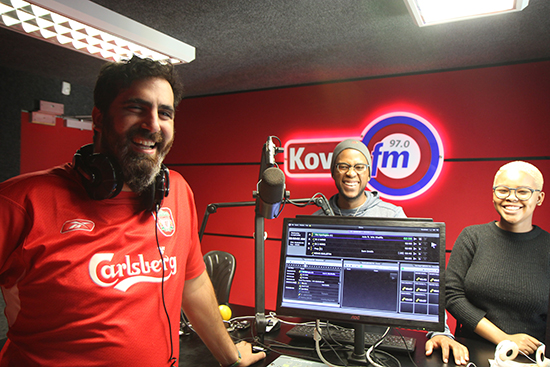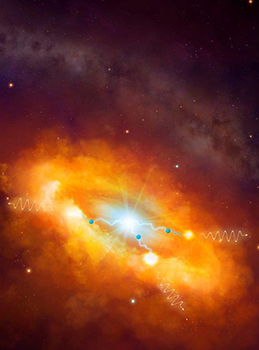Latest News Archive
Please select Category, Year, and then Month to display items
13 April 2018
Photo Moeketsi Mogotsi
 A brisk morning at work in studio with the Breakfast show team, Richard Chemaly, Sam Ludidi and Orefiloe Kelane.
A brisk morning at work in studio with the Breakfast show team, Richard Chemaly, Sam Ludidi and Orefiloe Kelane.
Kovsie FM’s breakfast show is in the race to win the “Best Breakfast Show for Campus Radio” in this year’s Liberty Radio Awards. This comes after the station’s first national radio awards-nomination in the history of Kovsie FM.
The Kovsie FM Breakfast show has evolved over the years, and was dubbed the #MonateFelaBreakfast in January 2018 by co-presenters Richard Chemaly (Chem) and Orefile Kelane (Fifi).
“The one thing you want to avoid when you wake up is being miserable, and the only way you can achieve that is by focusing on being happy,” said Chemaly. This realisation was a crucial turning-point for the show. The hot -duo carried on to say they wanted to make a distinction between themselves and other radio breakfast shows locally and nationally.
Inspired by a need for revolution and a closer relationship with its audience, #MonateFelaBreakfast re-examined and focused the crux of its content on the heartbeat of society, allowing the topical interests of the listeners to determine the subject of discussion or theme choice.
The appeal of the show does not rely on bringing super famous personalities as guests, but to allow up-and-coming artists to use the show as a catalyst to break through to success in their respective industries.
Chemaly and Kelane attribute their chemistry to understanding the old and new school elements of radio. They said transformation also plays an important part in the show’s lucky charm.
Two scientists part of team that discovers the source of the highest energy cosmic rays at the centre of the Milky Way
2016-03-22

Artist's impression of the giant molecular clouds surrounding the Galactic Centre, bombarded by very high energy protons accelerated in the vicinity of the central black hole and subsequently shining in gamma rays.
Artist's impression: © Dr Mark A. Garlick/ H.E.S.S. Collaboration Spotlight photo:
Dr Brian van Soelen and Prof Pieter Meintjes of the UFS Department of Physics.
Photo: Charl Devenish
|
H.E.S.S. (High Energy Stereoscopic System) scientists publically revealed their latest galactic discovery in the international science journal, Nature, on 16 March 2016. These scientists were able to pinpoint the most powerful source of cosmic radiation – which, up to now, remained a mystery.
Part of this team of scientists are Prof Pieter Meintjes and Dr Brian van Soelen, both in the University of the Free State (UFS) Department of Physics. Dr Van Soelen explains that they have discovered a proton PeVatron – a source that can accelerate protons up to energies of ~1 PeV (10^15 eV) – at the centre of the Milky Way. The supermassive black hole called Sagittarius A has been identified as the most plausible source of this unprecedented acceleration of protons.
The protons are accelerated to Very High Energy (VHE) gamma rays. The energy of these protons are 100 times larger than those achieved by the Large Hadron Collider at CERN (the European Organization for Nuclear Research).
According to Dr Van Soelen, the fact that this research has been published in Nature demonstrates the importance and pioneering nature of the research conducted by H.E.S.S. The H.E.S.S. observatory – operational in Namibia – is a collaboration between 42 scientific institutions in 12 countries.
In 2006, H.E.S.S. was awarded the Descartes Prize of the European Commission – the highest recognition for collaborative research – and in 2010 the prestigious Rossi Prize of the American Astronomical Society. The extent of the observatory’s significance places it among the ranks of the Hubble Space Telescope and the telescopes of the European Southern Observatory in Chile.
“The next generation VHE gamma-ray telescope,” Dr Van Soelen says, “will be the Cherenkov Telescope Array (CTA), which is currently in the design and development stage.” Both Dr Van Soelen and Prof Meintjes are part of this project as well.
H.E.S.S. has issued a complete statement about the paper published in Nature.